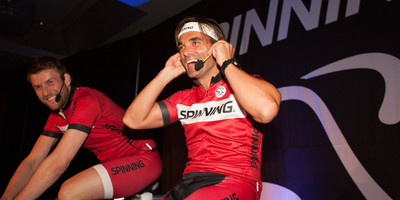
Creating Cues that Reach Every Rider
Posted by Spinning® on Apr 18th 2018
By Greg MantellHow do you stay motivated? As fitness professionals, we all have an intrinsic motivation to exercise every day and stay in peak physical condition. And like you, your students have the same built-in desire that keeps them on the track toward achieving their fitness goals. But there are times when we could use a little outside help to keep ourselves focused, excited and empowered when it comes to health and wellness. After all, there are those days when the outside world is telling us to stay inside or take the morning off.As Certified Spinning® Instructors, your words have an enormous impact on keeping your riders motivated and informed. But how do we know if we are reaching every student? How do we guarantee that our words are making maximum impact for our riders that will foster positive changes that will last a lifetime? With those burning questions in mind, the Spinning program has developed a brand new live workshop centered around an invaluable new technique; 3-part cuing. With this powerful new tool, instructors can be sure that their words will reach every rider regardless of their experience level, background or learning style.
What is a Learning Style?
For decades, scientist have analyzed and examined the process of learning so that we can better understand how we process and retain information. The most common theory today is that everyone possesses different learning styles, or ways by which we acquire information (1). Although there are lots of different ways to break down learning styles, the most widely accepted model (first developed by Walter Burke Barbe in the late 1970s) affirms that they are three primary learning styles; auditory, visual and kinesthetic (2 and 3). Let’s look at each of these learning styles in detail:Auditory learners learn by hearing. They prefer that you explain techniques using explanations and descriptive words. Music is another effective means of reaching these students. Visual learners learn by seeing. They prefer to watch and imitate demonstrations and generally need less explanation to grasp a certain concept. Kinesthetic learners learn by doing, touching, and experiencing. These students prefer to execute the technique and be “hands-on”.Even though you may have a preferred way of learning, we all use a combination of all of these learning styles every day. A good technique before you start developing new cues and instructions for your class is to look at yourself and your personal style. How do you learn or process information? Do you learn through sounds, visuals or actions, or some combination of the three? Examining the ways in which you learn effectively is the first step in creating effective communication strategies that will reach every rider in your class.
What Are 3-Part Cues?
3-Part Cues are designed to motivate and educate all students regardless of their learning style. You may not realize it, but you use a combination of auditory, visual and kinesthetic cues all the time. With this new 2-hour workshop, you will be able to hone those skills and ensure that your riders process and retain and important information according to their learning style. They not only provide motivation, but also elicit positive responses and action in your students.The new workshop features dozens of these cues for nearly every situation that could come up in class, including three ride profiles that incorporate these sample cues. For instance, one scenario explored is when a rider is in Hand Position 3 while in the saddle, which is contraindicated in the Spinning program. This is the perfect opportunity for riders to hear, see and feel this correction with one simple cue.
Become Both a Coach and a Teacher
The concept of 3-Part Cues is based in many of the same teaching strategies that many education experts use today. Perhaps the most valuable strategy employed in the development of 3-Part Cues is the simple “Tell, Show, Do” method. The workshop explains this simple coaching practice to enable you to enhance your Spinning training sessions for all your riders regardless of their individual style or experience level. You can be sure that you reach everyone wherever they are on their fitness journey and help them lead a healthier life.So think about what keeps you motivated? How do you learn new things and put them into action? It could be an inspirational quote, a powerful demonstration, or taking steps to complete a project. But no matter what keeps you and your riders coming to class every day, it all starts with your words as an instructor. And the Spinning program remains devoted to helping you continue to develop your skills and be the very best instructor you can be.
References
(1) American Council on Exercise. (2010). Ace Personal Trainer Manual: The Ultimate Resource for Fitness Professionals, Fourth Edition. 53-54.(2) Farwell, Terry. “Visual, Auditory, Kinesthetic Learners:. Family Education Network. Found at: http://school.familyeducation.com/intelligence/teachingmethods/38519.html#ixzz3VL3KnC00(3) Reyes, Stephanie. (2013). “Communication Styles: Auditory, Visual, Kinesthetic” TribeHR. Found at: http://tribehr.com/blog/communication-styles-auditoryvisual-kinesthetic
